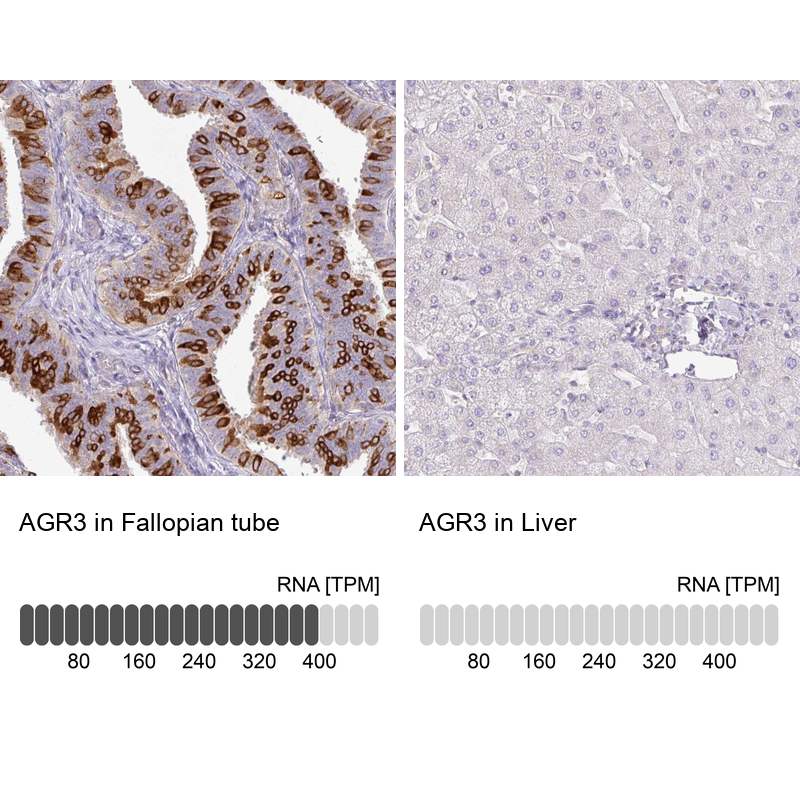![IHC-P analysis of breast carcinoma tissue using GTX80241 AGR3 antibody [AGR3.1]. IHC-P analysis of breast carcinoma tissue using GTX80241 AGR3 antibody [AGR3.1].](https://www.genetex.com/upload/website/prouct_img/normal/GTX80241/GTX80241_20191028_IHC-P_1_w_23061322_611.webp)
IHC-P analysis of breast carcinoma tissue using GTX80241 AGR3 antibody [AGR3.1].
AGR3 antibody [AGR3.1]
GTX80241
ApplicationsImmunoFluorescence, Western Blot, ImmunoCytoChemistry, ImmunoHistoChemistry, ImmunoHistoChemistry Frozen, ImmunoHistoChemistry Paraffin
Product group Antibodies
TargetAGR3
Overview
- SupplierGeneTex
- Product NameAGR3 antibody [AGR3.1]
- Delivery Days Customer9
- ApplicationsImmunoFluorescence, Western Blot, ImmunoCytoChemistry, ImmunoHistoChemistry, ImmunoHistoChemistry Frozen, ImmunoHistoChemistry Paraffin
- CertificationResearch Use Only
- ClonalityMonoclonal
- Clone IDAGR3.1
- Concentration1 mg/ml
- ConjugateUnconjugated
- Gene ID155465
- Target nameAGR3
- Target descriptionanterior gradient 3, protein disulphide isomerase family member
- Target synonymsAG-3, AG3, BCMP11, HAG3, PDIA18, hAG-3, anterior gradient protein 3, anterior gradient homolog 3, anterior gradient protein 3 homolog, breast cancer membrane protein 11, protein disulfide isomerase family A, member 18
- HostMouse
- IsotypeIgG1
- Protein IDQ8TD06
- Protein NameAnterior gradient protein 3
- Scientific DescriptionThis gene encodes a member of the disulfide isomerase (PDI) family of endoplasmic reticulum (ER) proteins that catalyze protein folding and thiol-disulfide interchange reactions. The encoded protein has an N-terminal ER-signal sequence, a catalytically active thioredoxin domain, and a C-terminal ER-retention sequence. This gene is expressed in ciliated airway epithelial cells and, in mouse, plays a role in ciliary beat frequency in multiciliated cells. This gene is also over-expressed in breast, ovarian, and prostrate cancers. [provided by RefSeq, Dec 2016]
- Storage Instruction2°C to 8°C
- UNSPSC12352203

![WB analysis of T47D and H1229 cell lysate using GTX80241 AGR3 antibody [AGR3.1]. WB analysis of T47D and H1229 cell lysate using GTX80241 AGR3 antibody [AGR3.1].](https://www.genetex.com/upload/website/prouct_img/normal/GTX80241/GTX80241_20191028_WB_1_w_23061322_445.webp)


![WB analysis of T47D and H1229 cell lysate using GTX80240 AGR3 antibody [AGR3.2].](https://www.genetex.com/upload/website/prouct_img/normal/GTX80240/GTX80240_20191028_WB_1_w_23061322_720.webp)


